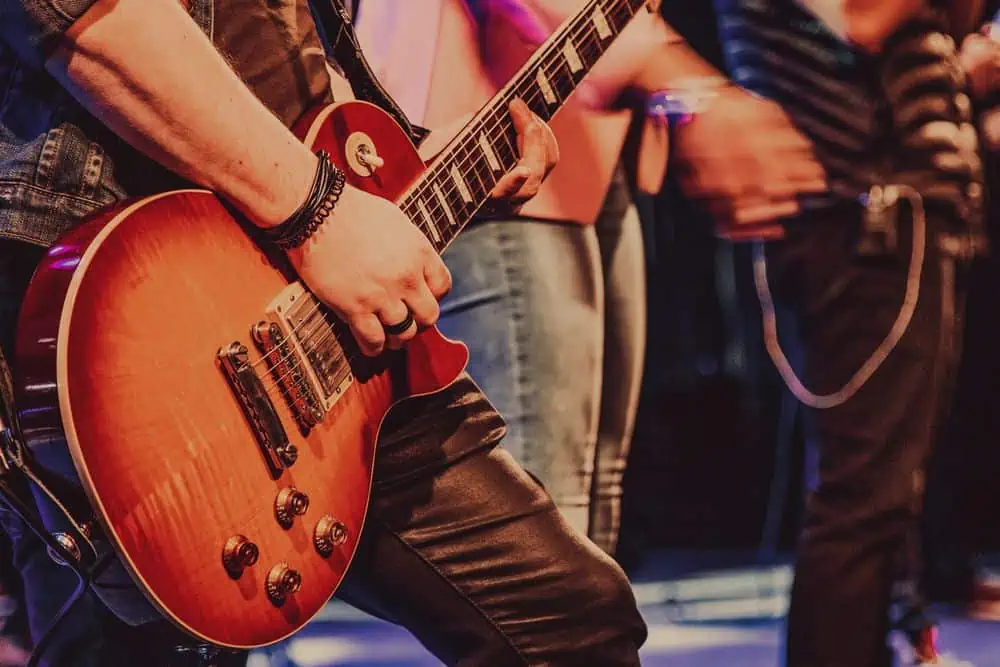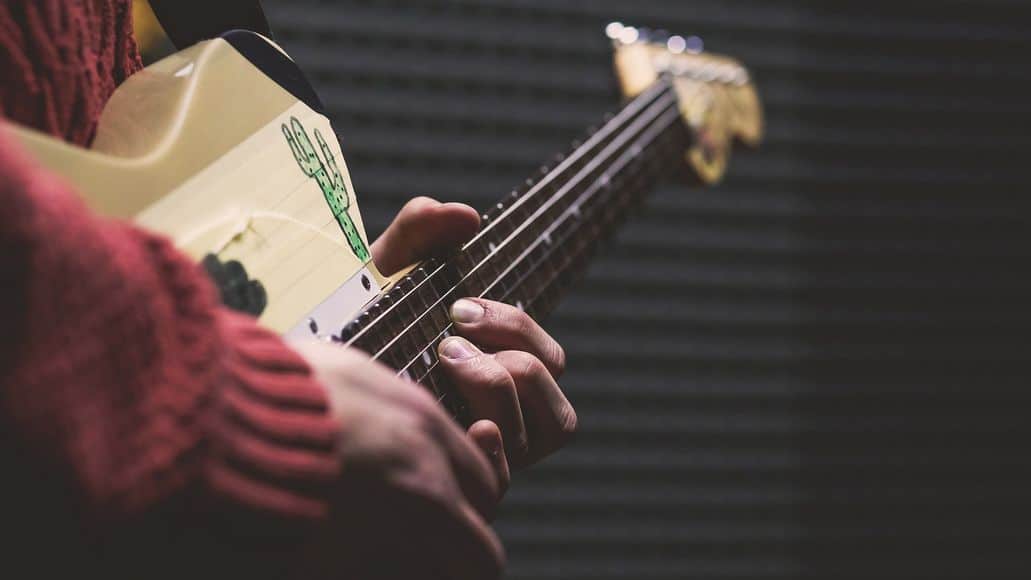
But do we really?
Some riffs we hear and instantly know they are a riff.
But there are many others that very few would recognize as such.
It turns out the term encompasses many more things than most realize.
So what is a guitar riff then?
Well, it includes the obvious, but also a lot of things that are far from obvious.
Keep reading to learn exactly what a riff is in guitar and how it differs from other, similarly arbitrary, separations we use to describe songs.
Table of Contents
What Is A Guitar Riff?
The term “guitar riff” describes a complete string of notes or chords in any song that either provides the base for other instruments or gels with other instruments to create a theme. It’s a part of a song whose beginning and end are typically apparent.
Riffs are usually played by the rhythm guitar, while lead guitarists often layer the song with “licks” to give it more character and nuance. Learn more in our article comparing rhythm guitar vs lead.
All songs are unique. It perhaps isn’t quite right to attempt to categorize any artistic effort into “riff”, “lick”, or “that part”. But for musicians, this separation can be quite useful.
Whenever a guitarist shows off a new “riff”, they want the band to play over it. Or at least that’s how my old band used to make most of our songs.
To better understand what a guitar riff can be, I want to give you a couple of examples, as well as useful hints on how to distinguish guitar riffs from any other parts in a song.
A Riff Can Be A Chord
Some of the most memorable songs are usually simple ones. And the first thing that comes to mind along those lines is Tomorrow Never Knows by The Beatles.
If you’re hearing it for the first time, you’d probably never guess it is built around a single chord. It’s the fact that it is layered with dozens of licks on various instruments (conventional and a bit less conventional) that makes it sound more complex than it actually is.
Another interesting use of a single chord as a guitar riff can be heard in the song Twilight Innocence by the band Novembers Doom. Throughout the entire song, you can hear the A Minor chord. The acoustic guitars play simple arpeggios to “dissect” this riff and make it more colorful.
And then there are “core” bands (metalcore, deathcore, mathcore, and such). So many of these bands have separated themselves from their parent genre by playing open power chords (usually in drop tunings) in a different rhythm.
Or A Combination Of Chords
Most people associate guitar riffs with a string of guitar chords. If you open up Spotify and randomly select any song from virtually any genre, there’s a good chance that its guitar riffs feature at least two different chords.
This is quite normal, since the extra notes in the second (third, fourth, and so on) chord open up more options for the other instruments to utilize different fills, whether it be a simple lick to make the song fuller or a melody that grabs the attention of the listener.
AC/DC’s Thunderstruck, for instance, uses a simple combination of B5 and A5 chords to compose the main riffs. These rock idols are known for heavily relying on power chords rather than “standard” chords, so even though there are two chords in the riff, only three notes are actually fretted in this case.
A Guitar Riff Can Be Comprised Of Single Notes
Although it is far less common than the alternatives, guitar riffs can also be made up of single notes. Almost by default, lead guitar players might make guitar licks with single notes played on higher strings.
But some guitarists have made riffs that transcend music genres, by keeping things super-simple. And yes, I’m mainly talking about Black Sabbath’s legendary Tony Iommi, who has made some amazing easy guitar riffs.
In case you didn’t know, Tony had suffered a major work-related incident and lost several fingertips on his fretting hand. Fretting power chords was quite hard for him, so he used single notes instead. Just listen to Black Sabbath’s namesake tune or Electric Funeral, and you’ll understand.
Single-note riffs were also somewhat popular among old-school death metal bands. The perfect example, would be Spirit Crusher by Death. Even though it lasts nearly seven minutes and features multiple different riffs, there’s hardly a chord in it.
It Isn’t Always A String Of Notes
As a rule of thumb, you can almost always assume that a riff is a combination of at least a couple of notes. However, there are many exceptions where a single note sustained for several minutes is the main riff.
A perfect example is Primordial’s Solitary Mourner from the album Journey’s End. The song opens up with a single hit of a B note, which is sustained for 2 minutes and 50 seconds. Alan, the singer, colors the song with his voice, but the main riff, main theme, hook, and pretty much everything else is just one note.
Drone metal bands, with one the most popular being Sunn O))), are famous for using incredibly low tunings and using a single chord (or even just one note) as guitar riffs.
Distinguishing A Guitar Riff From A Guitar Lick
When both guitarists in a band are so proficient at their instruments, it’s sometimes hard to tell who plays rhythm and who plays lead. The same can be said about separating guitar riffs from licks in bands that are known for their intricate guitar works, such as Opeth or Dream Theater.
No matter how complex a song might be, there’s a simple rule that will help you determine which parts are riffs and which parts are licks. The only thing you need to do is determine which parts are “underneath” and which are played “above” the rest of the song.
The parts that are “underneath” are usually somewhat simpler and are often played on the lower strings. Sometimes it’s hard to tell whether a harmonization between two guitar tracks is a riff or a lick, in which case you can apply the second rule – does the part repeat? If it does, it’s a riff.
Licks are essentially incomplete, often improvised, parts meant to make rare appearances and improve the dynamics of a certain (established) part. In a way, guitar solos are basically guitar licks strung together.
That’s why I said that you’ll be able to recognize a guitar riff, if you know where it starts and ends. Guitarists usually finish a riff on specific notes or chords that harmonically match the beginning of the same riff, so it can be played in a loop indefinitely.
What Is A Riff In Guitar: Final Thoughts
The term “riff” is not a technical term in music. It showed up in music way back in the 1920s to describe a repeated pattern or melody in a song. It has mostly retained that definition.
But, as you can see from the varied examples throughout this article, what a riff is can differ considerably. All it really needs to be is a repeated part of a song. And that can mean a lot of different things. For some great examples, check out our list of the best opening guitar riffs here.




Leave a Reply